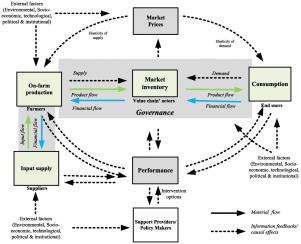Agricultural Systems ( IF 6.6 ) Pub Date : 2021-01-15 , DOI: 10.1016/j.agsy.2020.103044 Yanti Nuraeni Muflikh , Carl Smith , Ammar Abdul Aziz

|
Value chain analysis has been widely used as a diagnostic approach to identify and address complex issues across value chains in an agricultural development context. While comprehensive, the method is primarily qualitative and static in nature, it has limited capability in capturing the dynamic interactions between components from production to consumption and their linkages within a complex system. The application of system dynamics in value chain analysis has the potential to address the limitations. We conducted a systematic literature review to synthesise the underlying reasons behind the application of system dynamics in value chain analysis and understand how it has been operationalised. Results show that the primary reasons why system dynamics is used in value chain analysis were improved ability in capturing the feedbacks, dynamic behaviours and time delays, modelling the dynamics of governance and roles of support systems over time, incorporating multiple causal factors, and measuring performance and policy interventions over time. This can be broadly attributed to the need to improve the analytical rigour of value chain analysis. The applications of system dynamics in value chain analysis varied according to the agricultural commodities analysed, the modelling process followed, dynamic complexity modelled, and the scope of the value chain components analysed. We discuss the contributions, limitations, and opportunities for future improvements. A preliminary framework is proposed to improve the application of system dynamics in value chain analysis.
中文翻译:

系统动力学对农业发展价值链分析的贡献的系统综述
价值链分析已被广泛用作诊断方法,以识别和解决农业发展背景下价值链中的复杂问题。该方法虽然全面,但本质上主要是定性的和静态的,但是在捕获从生产到消耗的组件之间的动态交互以及它们在复杂系统中的链接时,能力有限。系统动力学在价值链分析中的应用有可能解决这些局限性。我们进行了系统的文献综述,以综合分析系统动力学在价值链分析中的应用背后的根本原因,并了解其如何被实施。结果表明,在价值链分析中使用系统动力学的主要原因是提高了获取反馈的能力,动态行为和时间延迟,随着时间推移对治理和支持系统角色的动态建模,合并多个因果因素以及随着时间的推移评估绩效和政策干预措施。这可以广泛归因于需要提高价值链分析的分析严格性。系统动力学在价值链分析中的应用会根据所分析的农产品,所遵循的建模过程,动态复杂性以及所分析的价值链组成部分的范围而有所不同。我们讨论了未来改进的贡献,局限性和机会。提出了一个初步的框架来改进系统动力学在价值链分析中的应用。纳入多个因果因素,并评估一段时间内的绩效和政策干预措施。这可以广泛归因于需要提高价值链分析的分析严格性。系统动力学在价值链分析中的应用会根据所分析的农产品,所遵循的建模过程,动态复杂性以及所分析的价值链组成部分的范围而有所不同。我们讨论了未来改进的贡献,局限性和机会。提出了一个初步的框架来改进系统动力学在价值链分析中的应用。纳入多个因果因素,并评估一段时间内的绩效和政策干预措施。这可以广泛归因于需要提高价值链分析的分析严格性。系统动力学在价值链分析中的应用根据所分析的农产品,建模过程,动态复杂度以及价值链组成部分的范围而有所不同。我们讨论了未来改进的贡献,局限性和机会。提出了一个初步的框架来改进系统动力学在价值链分析中的应用。系统动力学在价值链分析中的应用会根据所分析的农产品,所遵循的建模过程,动态复杂性以及所分析的价值链组成部分的范围而有所不同。我们讨论了未来改进的贡献,局限性和机会。提出了一个初步的框架来改进系统动力学在价值链分析中的应用。系统动力学在价值链分析中的应用会根据所分析的农产品,所遵循的建模过程,动态复杂性以及所分析的价值链组成部分的范围而有所不同。我们讨论了未来改进的贡献,局限性和机会。提出了一个初步的框架来改进系统动力学在价值链分析中的应用。


























 京公网安备 11010802027423号
京公网安备 11010802027423号